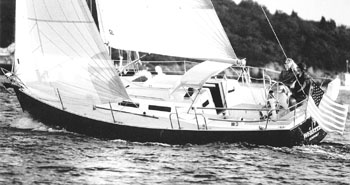 by
Thom Burns
by
Thom Burns

Itís always great to sail with an enthusiastic new boat owner. The excitement, sometimes the nervousness of owning a new boat and the correctness of decisions often long pondered are in the air. Mac and Kris Baird with their new J/32 have good reason to be excited about their choice.
Mac and Kris, native Minnesotans who lived for five years in Wabasha, Minnesota just south of Lake Pepin have been boat owners and sailors for over 30 years. Before going out east to the Syracuse, New York area they had owned several boats culminating in a thirty foot Tartan on Lake Pepin. On Lake Ontario they purchased a J/40 which they kept at Sacket's Harbor, New York. They sold the J/40 when they returned to the Twin Cities three years ago. They went boatless prior to buying the new J/32 from Brian Jepsen at Hooperís Yachts in Afton, Minnesota.
The Bairds have "boated down" to the J/32. "I always liked the builderís quality and performance in the J/40," said Mac. "What I was looking for in the J/32 was a smaller, easier package for a couple to manage with plenty of room, all the new technical advances and performance." The Bairdís added all the option packages, some extra teak down below and the carbon fiber mast and boom package. Mac also loves blue boats which led to a paint job by a Rhode Island painter who regularly paints custom J color jobs.
The J/32 was designed by Alan Johnstone, the son of the legendary Rod Johnstone who has designed all other J/Boats beginning with the J/24 over 20 years ago. The J/32 is a cruising boat for a couple or a family of four (it sleeps five with the optional settee berth). All modern J/Boats, race or cruise, are designed to be sailed with a short-handed crew. For example, the new forty footer could be raced with a crew of four including using the asymmetrical spinnaker. The best kept secret in the sailing industry is that J/Boats also builds some great cruising boats. The J/32 is very easy to handle.
The Test Sail
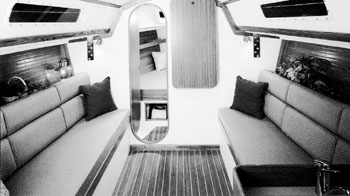
The helm on the J/32 is remarkably sensitive using the forty inch "destroyer" wheel. Itís so well balanced that it is easy to oversteer the boat until you get used to it. With the asymmetrical spinnaker up in about 11.5 knots of wind the boat didnít heel much nor did it give any hint of "hard to handle" even at sixty degrees apparent wind angle. My race boat would at least give me a hint or two that rounding up would soon be a possibility in a puff. I was not the only one impressed with the ease of sailing and the incredible "feel" of the J/32. Duke and Mary Richards of Stillwater who were aboard for the test sail were very impressed. They thought it was easier than an extensive list of other boats they had looked at to double-hand.
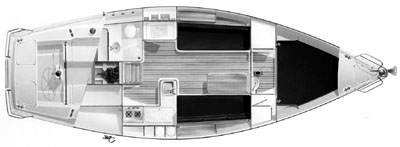
Why this boat heels so little, sails so well and with such ease is slightly complex when related to a sound bite. It starts with the design which uses a 29 foot waterline on a 32 foot hull. Then you have TPI building the boat using their patented SCRIMP process. This system pulls triple the normal vacuum bagging levels to draw air out of cored hull and deck laminates and resin into every void, all in a single production step. Even the entire J/32 keel structural grid cures with the hull as a primary bonded component. The net results of this technology are high strength, light weight and void free hull and deck laminates. The traditional hand lay-up and the chopper gun construction techniques are heavier and inferior according to TPI and many others. The weight saved is then added back at the lowest center of gravity, the keel, in the form of a lead bulb shaped as an inverted wedge with a tapered tail aft. To complete the weight picture, the Bairdís put a carbon fiber mast and boom on the boat which saves an additional 100 lbs aloft. The net result is the boat sails on its feet, the most efficient way to sail.
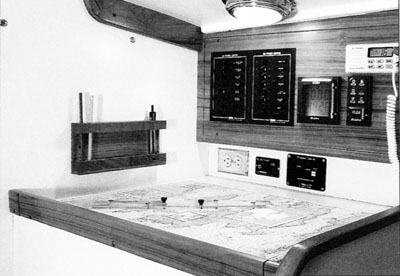
On Deck
One of the best attributes of the J/32 according to Bill Hooper is that a customer does not have to upgrade stock hardware when buying the boat. I found the self-tailing winches, the traveler, the mainsheet and the stock hydraulic backstay to be just what an experienced customer would order. I agree with Bill on this important point. We had six people in the roomy, comfortable cockpit. Two more would max it out. The cockpit has two very large lazarettes for stowing gear and a vented, gasketed one made for the propane tank. Each is rimmed on the interior with a draining lip which prevents water from going into the bilge when washing down, etc. The helm seat is comfortable and the visibility is good both through the dodger and to the jib and main.
The side decks on the J/32 are wide and easy for going forward. The double lifelines, stainless steel handrail and open bow pulpit are very functional and safe. The anchor locker is self-contained and drains overboard rather than into the bilge. In general the deck is uncluttered and easy to manage.
Down Below
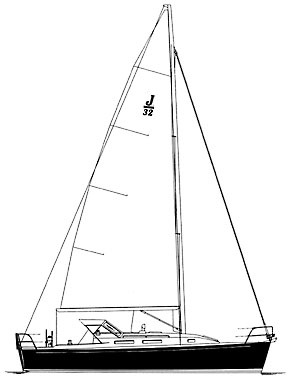
The L-shaped galley to starboard is very workable with a molded, deep sink integral to a Granicoat counter top. It includes hot & cold pressure water, a large well insulated icebox, 2-burner Force-10 LPG range, and dedicated trash storage with flip lid access. Open the door aft and you have access to the very large stowage area under the starboard side of the cockpit.
The navigation table is large enough with a hinged-top, large drawer, tool cabinet below and complete DC electrical center.
As you walk forward, the trim doubles as hand-holds. Tankage is under the settees. The floor boards all pull up for access. Engine access below the companionway ladder, in the starboard storage room and from the port lazarette is excellent. The substantial structural bulkhead supports the shroud chainplates. This bulkhead was changed to teak by the Bairdís. Forward is the ownerís double V-berth stateroom which also has 6í3" headroom. The stateroom has a 2 drawer bureau, vanity with sink and mirror and a hanging locker large enough to store a permanent "on-board" wardrobe. There is also substantial storage under the berth.
The head/shower/wet hanging locker compartment is on the port side of the companionway aft. According to J/Boats the one-piece molded unit is copied from units installed in over 100 plus J/40s & J/42s. The unit incorporates a shower sump with dedicated pump and strainer system. I found the unit to be good sized for a 32 footer. The Bairds installed additional cockpit showers.
Ventilation is provided by two dorade intakes, as many as eight opening ports, three deck hatches and the large dodger-protected companionway hatch. With the addition of an autopilot the companionway and dodger function as a soft-topped pilot house when passage-making in bad weather.
Conclusion
Seventy-five to ninety percent of all sailboats sold are used, I asked myself and in this case the Bairds what makes this new boat purchase make sense? The J/32 answer is clearer than most. Youíre getting ten virtually worry free years on the hull with the transferable blister warranty. Youíre getting a boat which sails much bigger, faster and most importantly easier than the comparable used boat. It would be somewhere between difficult and impossible to modify a used hull to get matching specifications. The expense would be significant. Youíre getting a modern interior and a state of the art cruising rig. Youíre getting a boat you can be proud of for years to come. The ideal cruising boat for many years has been the classic 40 foot sloop. For many, this may no longer be true. When a 32 footer feels like a 40 footer youíre going to sail with a smile. Bring along a great conversationalist and a well stocked library, thereís not much to do!
Thom Burns publishes Northern Breezes and Sailing Breezes.
Bill Hooper owns Hooper's Yachts in Afton, Minnesota.
For more information:
Hooper's Yachts: 651-436-8795
J/Boats: 401-846-8410
All contents are copyright (c) 1998 - 2003 by Northern Breezes, Inc. All information contained within is deemed reliable but carries no guarantees. Reproduction of any part or whole of this publication in any form by mechanical or electronic means, including information retrieval is prohibited except by consent of the publisher.